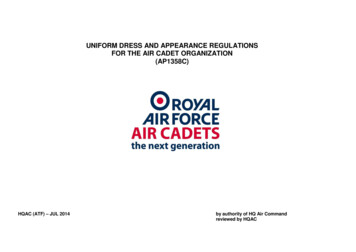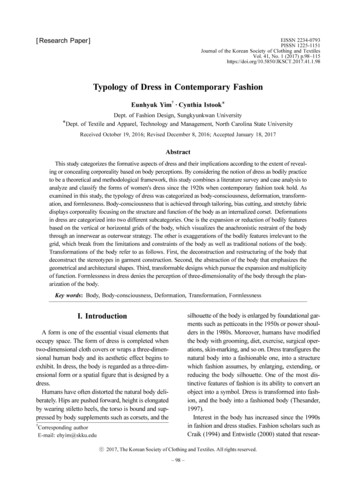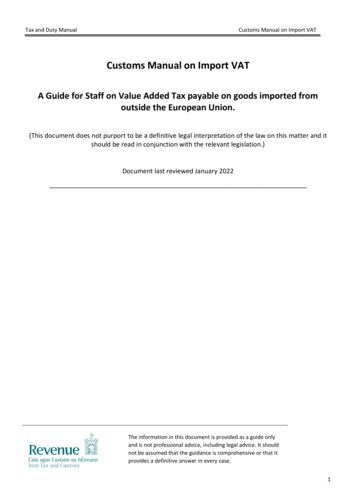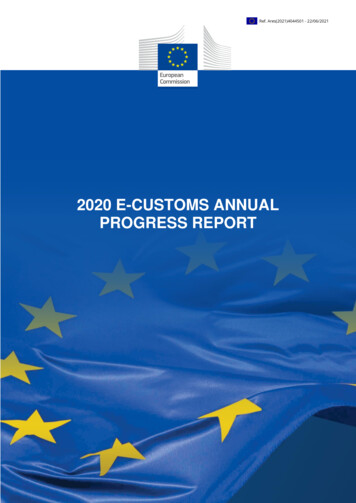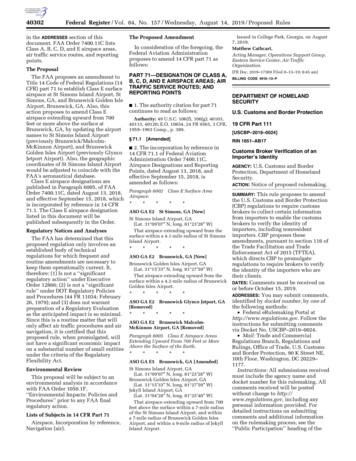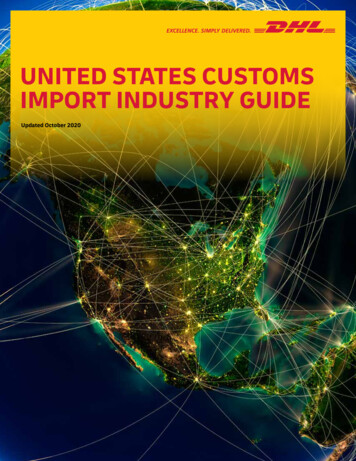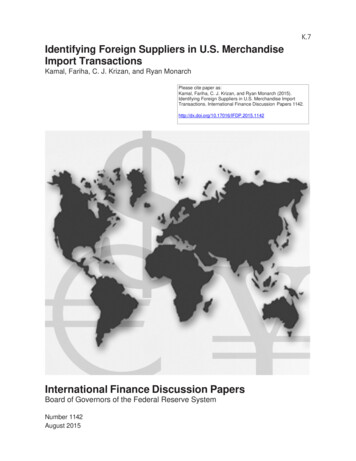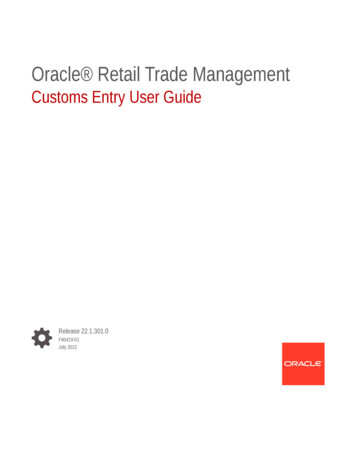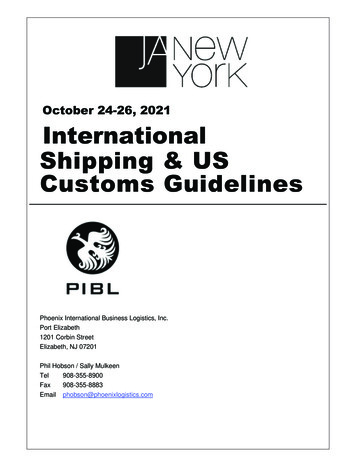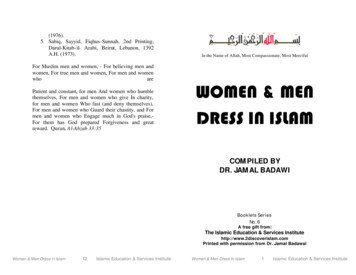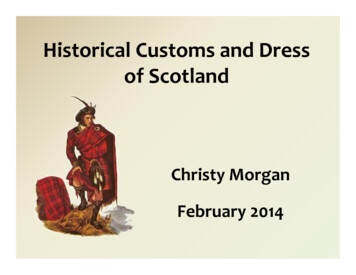
Transcription
Historical Customs and Dressof ScotlandChristy MorganFebruary 2014
Traditional Highland Dress - MaleIncludes:Kilts (“skirts”) or Trews (trousers)Sporran – pouches worn around thewaist to function as pocketsSgian Dubh – short-bladed knifetucked into the kilt hoseGhillies Brogues – tongueless shoes
Dress Act of 1746The Dress Act of 1746 was part of the Act of Proscription which made wearing“the Highland Dress” illegal in Scotland. The intended purpose was toweaken Scottish support for the restoration of the Stuart King James II ofEngland to the thrones of England, Scotland, and Ireland known as theJacobite Risings, which occurred between 1689 and 1746.Punishment for Noncompliance – “For the first offence, shall be liable to beimprisoned for 6 months, and on the second offence, to be transported toany of His Majesty's plantations beyond the seas, there to remain for thespace of seven years.” (Wikipedia – Dress Act)The law was repealed 36 years later in 1782. By that time, kilts and tartanswere no longer ordinary Highland wear.
Clan TartansEvidence in the literature suggests that the concept of a tartan beingassociated with an particular clan may be a relatively modern invention (after1745). Some writings suggest that clan identification was achieved solelythrough decoration of the bonnet with the clan crest, colored ribbons, orother items such as sprigs of heather or feathers.At a meeting of the Celtic Union in Edinburgh in 1948, it was stated by LordLyon King of Arms, Sir Francis J. Grant that :“Records establish that tartans had been worn in Scotland as far backas 1440. But present-day tartans were not old. They only went backto the reign of George IV. Tartans worn before 1745 were quitedifferent.”
Kilt Made of woolen cloth with a tartanpattern. Knee length with pleats inback. Identified as traditional Scottishdress in the 16th century. Historically informal wear, butusually considered formal wear today. The modern kilt evolved from the“belted plaid” or “great kilt,” a fulllength garment whose upper half wasworn as a cloak draped over theshoulder (see picture) or over thehead.http://en.wikipedia.org/wiki/KiltHighland chieftain Lord Mungo Murraywearing belted plaid, around 1680.
Kilt PinThe kilt pin is usually worn on the lower corner of the outer flap of a kilt. Itdoes not pin the outer fabric to the inner fabric, but instead is pinned to theouter flap to add weight, thereby preventing the flap from blowing open.Many kilt pins are decorated with clan symbols, national emblems, or nativeanimals and plants.
TrewsAlso written as:trowsetriubhas - Scottish Gaelictruis – anglicized spelling Woven tartan cloth trousersdating from 1538. Used in winter, during which thekilt did not provide adequatewarmth.Sir John Sinclair by Henry Raeburn,1794–95. Sir John wears leathertrimmed trews of fabric cut on thestraight grain.http://en.wikipedia.org/wiki/Trews
Trews – TraditionalTraditional trews are actually long hose, not trousers. These hose came all theway up to the waist and were attached to a linen cloth. They were fastened atthe lower leg, below the knee, by a garter. (The garter is the precursor to thegarter flashes shown in a later slide.)Battle of Culloden byDavid Morier,painted circa 1745,shows traditionaltrews with garter.www.reconstructinghistory.com
Trews – ModernModern trews are: more like trousers (i.e. less fitted). often high-waisted. usually to be worn with a short jacket. made from fabric cut on the straight grainbut without a side seam.http://www.blacktieguide.com
DressSporranDay Sporran simple pouch brown leather minimal decoration,with tassels or nTypesAnimal MaskSporran animal’s headused as closureflapHorse HairSporran used by militaryregiments andpiper bands larger than daysporrans highly decorated,often with sterlingor silver-platedcantles trimmingthe top of thepouch and a furcovered face withfur or hair tassels.
Ghillies BroguesFunctional Design No tongue on the tops of the shoes. Thisallows the shoes to dry more quickly afterbecoming wet. Long laces wrap around above the ankleand ties below the calves. This keeps thelaces clear of mud and prevents the shoesfrom coming off when being pulled fromhttp://en.wikipedia.org/wiki/Brogue shoemud.Despite their functional design, ghillies brogues are most often seen at formaloccasions.The ghillie brogue is named after the ghillie, the traditional Scottishgamekeeper and outdoorsman.
Kilt Hose and FlashesKilt hose are long woolen stockings normally worn knee-high with the upperpart of the hose folded back down to create a thicker cuff just below theknee. They can also be found in diced patterns, which are required wear forHighland dancers. The most common color of hose however, is the cream, or'off-white' hose, the color of unbleached hp?main page product info&products id 810http://www.your-kilt.com/kilt-hose.html
Kilt Hose and FlashesGarter flashes are straps worn inside the cuffof the hose to hold them in place. The flashesare short strips of fabric hanging from thegarter, mostly matching the tartan orcomplementary in color to the kilt fabric.Garter Flasheshttp://kiltshop.scottishtartans.org/garter flashes.html
Sgian-dubhThe sgian-dubh (pronounced skee-ənDOO) is a small, single-edged knife. Sgiandubh means “black or hidden knife.” TheSgian-dubh may have evolved from theSgian-dubh, a larger knife concealedunder the arm.In additional to serving as a utility knifeand as a weapon, the sgian-dubh wasused for preparing and eating meat andfruit and for cutting bread and an-weapon-fighting-61355/
Sgian-dubhThe sgian-dubh is worn tucked into the top ofthe kilt hose with only the upper portion of thehilt visible. It is normally worn on the right leg,but can also be worn on the left.The sgian-dubh may have evolved from thesgian-achlais, a larger knife concealed under thearmpit. Etiquette required guests to leave allweapons at the door, but custom allowedguests to keep one unconcealed weapon forself-defense. And so, a theory suggests that thesgian-achlais was removed from concealmentand placed in the kilt hose for ready access.http://en.wikipedia.org/wiki/Sgian-dubh
BonnetThe traditional Scottish bonnet is worn bymen.It is distinct from other folk bonnets, such asthe beret, in that it: is usually made of wool. has a toorie (pom-pom) in the center. has an external hatband which passesaround the head's landdress/modern/headgear/In the 19th century, the Scottish bonnet was nicknamed the Tam o' Shanter (orTam), after the hero of the Robert Burns’ poem of the same name.
Balmoral BonnetThe Balmoral bonnet (formerly known as the Kilmarnockbonnet, and named after Balmoral Castle) dates back toat least the 16th century. It is a knitted cap of soft woolwith a voluminous, flat crown. It is traditionally blue incolor and sometimes has a diced band (usually red-and-white check) around the lower edge and with a ess/modern/headgear/toorie (pom-pom) set in the middle of the crown. It canbe used with both formal and informal dress.It is an alternative to the similar and related Tam o'Shanter cap (informal wear) and the Glengarry bonnet(formal or informal wear) ient/
Glengarry BonnetThe Glengarry bonnet: is made of thick-milled woolen material. is decorated with a toorie (pom pom) on top. is frequently decorated with a rosette cockade on the left side. has ribbons hanging down from the back.It is normally worn as part of Scottishmilitary or civilian Highland dress, eitherformal or informal.cockade (often aknot of 0Glengarry%20Bonnet/prod 16071.htmlThe Royal Regiment of Scotland wearsthe Glengarry bonnet with a diced bandand black cock feathers as itsceremonial headdress.
Traditional Highland Dress - FemaleFrom Wikipedia:“Female highland dress includes women's shoes, also called ghillies, thatare tied in the same way but have thin soles for indoor wear and dancing.Traditionally, women and girls do not wear kilts but may wear ankle-lengthtartan skirts.A tartan sash or shawl may also be worn.Women may also wear dress tartans which are modified versions whichinclude white in place of a more prominent colour.”
ArisaidAn arisaid (pronouncedAIR-uh-sedge) isessentially a cloak thatextends to the heels. Itis usually made ofundyed wool with a fewbright lines or stripes onit. It is fastened at thebreast with a metalbrooch and around theModern Arisaid(with modern colors)waist with a tmlR. R. McIan's 1845illustration from"Costumes of the Clans"
ArisaidThe arisaid could also be used as ahead covering.William Sachceverell in 1688 writes:“The usual habit of both sexes is thepladd; the women’s much finer, thecolours more lively, and the squaremuch larger than the men’s, and putme in the mind of the ancientPicts. This serves them for a veil andcovers both head and body.”http://www.reconstructinghistory.com/
SashesSashes are worn across the upper half of the dress.Clanswomanhttp://www.tartansauthority.comThe wife of a clanchief or the wife of aColonel of a ScottishRegiment wouldwear a slightly widersash over the leftshoulder andsecured with abrooch on the leftshoulder.Ladies married outof their clan butwho wish to usetheir original clantartan.Often worn byScottish countrydancers or wherethe lady wishes tokeep the front ofher dress clear ofthe sash - as whenwearing the ribbonsor decorations ofany chivalric order.
Plaid Brooch or Cairngorm Brooch Used to fasten the tartan sash across thebreast. Cairngorm is a variety of smoky quartzcrystal found in the Cairngorm Mountains of1912Scotland. It usually has a smoky yellow-browncolor, though some specimens are a greyc. 1880brown.mid-1880s
Penannular Brooch (Celtic Brooch)Penannuar means that it does not form a complete circle. The brooches havea long pin attached by its head to a ring. The pin can move freely around thering as far as the terminals.To use: The pin was stabbed through thefolds of a cloak and then one end of thering was pushed under the sharp end ofthe pin where it came out of the cloth.The ring was then turned until the pin tiplay securely locked in place beyond theraised bump of the decorated terminal.Used to fasten the clothes, and thereforeoften larger than the plaid brooch.c. 1840
Penannular Brooch (Celtic Brooch)Penannular brooches were used as far back as the Iron Age and Romanperiod, but are especially associated with the highly ornate broochesproduced in precious metal for the elites of Ireland and Scotland from about700 to 900.They are the most significant objects in high-quality secular metalwork fromEarly Medieval Celtic art.8th centuryPictish penannular brooch,silver with gilding and glass
CUSTOMS Scottish Dance Highland Games Holidays National Symbols
Scottish DanceThere are many Scottish dances, however, traditional Scottish dancinggenerally falls into one of four main categories:Ceilidh – Very sociable, easy-going and good exercise when the paceincreases.Cape Breton Step Dancing – Mainly solo and for stage performance.Preserved in Nova Scotia by Scottish emigrants, and making a comebackin Scotland. Very similar to Irish hard shoe dancing.Scottish Country Dancing – A few couples arrange themselves either intwo lines or in a square, and complete a set of formations enough timesto bring them back to their opening positions.Highland Dancing – Performed in competition. Usually performed soloby young people. A very colorful and lively style of dance.
Aboyne DressAboyne Dress is the name given to theprescribed attire for female dancers in theScottish national dances.The Aboyne Dress is composed of a tartanskirt, a white blouse , and a velvet waistcoatwith a pinned-on sash.It was developed in the 1970s to createperformance attire for women that differedfrom the attire (kilt, jacket, bonnet, andsporran) worn by men.
Highland Games – Dance CompetitionThe Gillie Callum or “Scottish sword dance” wasrecorded from as early as the 15th century. In thedance, the dancer crosses two swords on the groundin an "X" shape and then dances around and withinthe four quadrants of the crossed culture/uniquely-scottish/highland-games
Highland Games – Music CompetitionThe highland games include a wide range of piping and drummingcompetitions, including solo piping and drumming, small group ensembles,and pipe bands. Other musical entertainment includes fiddling, harp circles,and Celtic ia-2347018
Highland Games – Athletic CompetitionWeight Over the BarThe weight is a steel or lead weight(with a bell, spherical or cylindricalshape) attached to a metal circularhandle.The weight is thrown one-handedover a bar set at increasing heightsabove the 8/highland-games-from-scotland.htmlThe size of the weight varies with thecompetition class. Advanced maleathletes throw a 56-lb /
Highland Games – Athletic CompetitionWeight ThrowAlso known as the weight for distance event. The longest throw wins.The weights are made of metal and have a handle attached either directly orby means of a chain. The weight is thrown using one hand only, usuallywith a spinningtechnique. The lightweight event has 28lb weights for menand the heavy weightevent has 56-lbweights for 155147.html
Highland Games – Athletic CompetitionCaber TossThe caber toss involves tossing of a large wooden pole called a caber, similar toa telephone pole or power pole. It is said to have developed from the need totoss logs across narrow chasms to cross them. In Scotland, the caber is usuallymade from a Larch pinetree and is typically19 feet 6 inches tall andweighs about 175 ghland-games/
Highland Games – Athletic CompetitionStone PutSimilar to the modern-day shot put.A large stone of variable weight is often used.brothersofbriar.forumotion.com
Highland Games – Athletic CompetitionMaide Leisg (Lazy Stick)Trial of strengthperformed by two mensitting on the ground withthe soles of their feetpressing against eachother. Thus seated, theyheld a stick between theirhands which they pulledagainst each other untilone of them was raisedfrom the ground.
Highland Games – Athletic CompetitionHammer ThrowThe goal is to throw the hammer the farthest.The men’s hammer weighs 16 pounds and measures 3 feet 11 3 4 inches in t.com/events/highland-games/
Highland Games – Athletic CompetitionSheaf TossThe sheaf toss was originally a traditional Scottish agricultural eventcontested at country fairs (not at the Highland Games). A pitchfork is usedto hurl a burlap bag stuffed with straw over a horizontal bar above thecompetitor’s head. Typical weight for the bag is 16-20 /http://mediagallery.usatoday.com/Grandfather Mountain Highland Games
HolidaysBurns Supper – 25 Jan – to celebrate the poet Robert BurnsLabour Day – early May – to celebrate the achievements of workersVictoria Day – late May – to celebrate the birth of Queen Victoria inrecognition of her contribution to Scottish societySt Andrew’s Day – 30 Nov – the feast day of St. Andrew, the patron saintof ScotlandBoxing Day – 26 Dec – official public holiday (by long-standing tradition)Hogmanay (New Year) – 31 Dec – to celebrate the beginning of a new yearReligious HolidaysGood Friday – spring – to commemorate the death of ChristEaster Day – spring – to celebrate the resurrection of ChristChristmas – 25 Dec – to celebrate the birth of Christ
National SymbolsDeclaration of Arbroath Declaration of Scottishindependence, made in 1320. The document is held at theVatican as it was originallysent to the Pope in the formof a letter.National AnthemOfficial AnimalUnicornNone officially, asScotland is not acountry.since 12th centuryHowever, The Flowerof Scotland is theunofficial anthem, andis used in sports eventsin which Scotlandcompetes.Many versions onYouTube, but this onesounds nice:http://en.wikipedia.org/wiki/Declaration of arbroathhttp://www.youtube.com/watch?v tland.html
National Symbols – St Andrew and the Flag of Scotlandhttp://en.wikipedia.org/wiki/Andrew the Apostle#ScotlandNational Flag known as the Saltire or St. Andrew’sCrossSt. Andrewhttp://en.wikipedia.org/wiki/Andrew the Apostle#Scotland use of a blue background is believed todate from at least the 15th century patron saint of Scotland from about the one legend related to a 9th centurymiddle of the 10th centurybattle states that the blue represents the martyred by crucifixion on X-shaped crosssky across which a miraculous saltire(i.e. saltire), according to legendappeared as a good omen
National Symbols – The Royal StandardScotland is unusual in that ithas two flags.From Wikipedia “The Royal Standard of Scotland,also known as the Banner of theKing of Scots or more commonly thehttp://en.wikipedia.org/wiki/Royal Standard of ScotlandLion Rampant of Scotland, is the Scottish Royal Banner of Arms. Usedhistorically by the King of Scots, the Royal Standard of Scotland differs fromScotland's national flag, The Saltire, in that its correct use is restricted by anAct of the Parliament of Scotland to only a few Great Officers of State whoofficially represent The Sovereign in Scotland. It is also used in an officialcapacity at Royal residences in Scotland when The Sovereign is not present.”
National Symbols – Floral EmblemFrom Wikipedia Cirsium vulgareSpear Thistlehttp://en.wikipedia.org/wiki/Cirsium vulgare“According to a legend, an invading Norse army wasattempting to sneak up at night upon a Scottish army'sencampment. During this operation one barefootNorseman had the misfortune to step upon a thistle,causing him to cry out in pain, thus alerting Scots to thepresence of the Norse invaders.Which species of thistle is referred to in the originallegend is disputed. Popular modern usage favoursCotton Thistle (Onopordum acanthium), perhaps becauseof its more imposing appearance, though it is unlikely tohave occurred in Scotland in mediaeval times; the SpearThistle (Cirsium vulgare), an abundant native species inScotland, is a more likely candidate. Other species,including Dwarf Thistle (Cirsium acaule), Musk Thistle(Carduus nutans), and Melancholy Thistle (Cirsiumheterophyllum) have also been suggested.”
ReferencesReconstructing History – The Evolution of the .scotland.com/scottish-dance/Tartan Authority – Ancient Highland s/ancient/Tartan Authority – The dress/modern/headgear/The Wearin’ O’ The dress.htmUnknown Scottish History – The Sgian een.phpWikipediahttp://en.wikipedia.org/wiki/
Traditional Highland Dress -Male Includes: Kilts ("skirts") or Trews (trousers) Sporran - pouches worn around the waist to function as pockets
